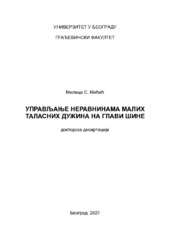Приказ основних података о документу
Management of short wave unevenness of the rail head surface
| dc.creator | Mićić, Milica | |
| dc.date.accessioned | 2021-12-21T11:07:44Z | |
| dc.date.available | 2021-12-21T11:07:44Z | |
| dc.date.issued | 2021 | |
| dc.identifier.uri | https://grafar.grf.bg.ac.rs/handle/123456789/2568 | |
| dc.description.abstract | The subject of the research presented in the Dissertation is a short wave unevenness of the rail head surface in contact with the wheel of the railway vehicle. The research aim is developing a methodology for management of short wave unevenness (λ < 1 m) that occurs due to the contact fatigue of rail steel (RCF). The management of unevenness on the running surface of the rail head is considered within the framework of sustainable development of railway infrastructure, considering the requirements of users, railways, economy, environment, social community and transport safety. The causes of appearance and development mechanism of the unevenness were considered, with particular reference to rail defects that directly threaten the safety of railway transport and adversely affect the environment, such as head checking, squat, belgrospi and different types of surface corrugations of the rail head. Guidelines for the development of the management strategy of RCF defects were considered. An overview of inspection methods for early detection of the mentioned defects was presented. Dissertation investigated the hypothesis that the track stiffness influences the appearance and development of the short wave unevenness of the rail head surface. The research results of the influence of the railway superstructure and substructure on the track stiffness, as well as the methods for vertical stiffness measurement were presented. The uneven track stiffness along the track was analysed from the aspect of the structure and maintenance. An experimental investigation of the influence of track stiffness on the occurrence and development of squat defects in Pančevo Varoš railway station was performed using the methods of general and detailed visual inspection of tracks, as well as electrometric and seismic methods on the test section. The analysis of the obtained measurement data proved the influence of the uneven track stiffness on the occurrence and development of squat defects. Guidelines for further research in this area were proposed. | sr |
| dc.language.iso | sr | sr |
| dc.publisher | University of Belgrade, Faculty of Civil Engineering | sr |
| dc.relation | info:eu-repo/grantAgreement/MESTD/MPN2006-2010/14057/RS// | |
| dc.rights | openAccess | sr |
| dc.rights.uri | https://creativecommons.org/licenses/by-nc-nd/4.0/ | |
| dc.subject | railway infrastructure | sr |
| dc.subject | rail defects | sr |
| dc.subject | short wave unevenness | sr |
| dc.subject | rolling contact fatigue of steel | sr |
| dc.subject | head checking | sr |
| dc.subject | squat | sr |
| dc.subject | track stiffness | sr |
| dc.subject | electrometric method | sr |
| dc.subject | seismic method | sr |
| dc.subject | inspection methods | sr |
| dc.title | Management of short wave unevenness of the rail head surface | sr |
| dc.type | doctoralThesis | sr |
| dc.rights.license | BY-NC-ND | sr |
| dc.rights.holder | Milica Mićić | sr |
| dc.identifier.fulltext | http://grafar.grf.bg.ac.rs/bitstream/id/9983/bitstream_9983.pdf | |
| dc.identifier.rcub | https://hdl.handle.net/21.15107/rcub_grafar_2568 | |
| dc.type.version | publishedVersion | sr |

